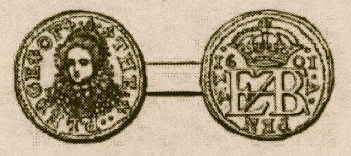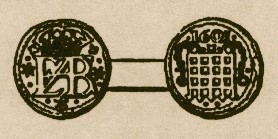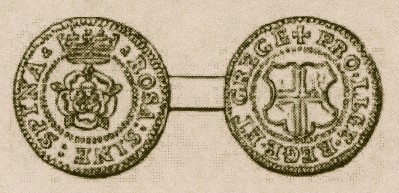

the first piece to be described is the so-called
Half Groat.
It is more than probable that the above was a medalet or jetton only, but the workmanship is evidently
contemporaneous with that of the following patterns struck in 1601.
Penny.
Halfpenny.
In Snelling, Pl. V., No. 14, the legend on the reverse is erroneously spelt HALFPENNY.
Farthing.
The pattern figured in Snelling's Pattern Pieces, Pl. 5, No. 9, has the crowned monogram, but is evidently a pattern
for a silver piece and not for a copper coin.
In my collection (late Brice Coll.) is a silver pattern somewhat less in size than the present current farthing
of which the following is a description:
This was probably a trial piece struck at the Tower, and is more probably attributable to this Queen than to Edward
VI., although the initials used are common to both Sovereigns. The only other known example of the same piece formed
Lot 128 of the Devonshire Sale, and is now in the National Collection.
The following pieces are treated as patterns for coins, but may be jettons only. The first occurs in silver, and
less frequently in a kind of billon and in copper. These pieces have been ascribed to Charles I., and in Bergne's
Sale Catalogue (Lot 972) to Charles II., and although their similarity to the piece last described makes their
attribution to Elizabeth a possible one, it is more than probable that, having regard to their workmanship
and general appearance, they may have been issued at a somewhat later period.
Several dies were used for this piece, which is somewhat rare. On one silver specimen in my own cabinet there is
but one pellet before ROSA, two after SPINA, and an annulet after GREGE
on the reverse; on another, also in my cabinet (ex Brice Coll.), three pellets occur on the obverse after
ROSA and SINE, and there are no pellets at the beginning or end of the legend; on the
reverse there is a pellet between each word and one at the beginning and end of the legend; on a third specimen
belonging to me, the legend on the obverse is as follows: X ROSA. SINE. SPINA. and on the reverse:
+ PRO. LEGE. REGE. ET. GREGE [upside down triangle of three dots]. Mr. Hoblyn has a billon example,
reading ROSA: SINE: SPINA .. and with a cross before the reverse legend. On another also in my
collection, and apparently of copper, there is a pellet before ROSA, but none after SPINA,
and the annulet on the reverse is wanting, and on examples in the National Collection and in my own there are three
pellets in a pyramidal form before ROSA and after SPINA.
Both of these pieces were in the Devonshire Collection and are of much later workmanship and lettering than any
of the examples of No. 6, of which they appear to be mere imitations.
Leaden tokens issued by private persons were largely used in this and the earlier reigns. Some bear royal arms
and devices, but it is not likely that any were issued under royal authority. A copper piece mentioned by
Christmas, with BEATI PACIFICI on the obverse, and HOC OPVS DEI on the reverse,
and which he designates as a numismatic puzzle, must be attributed to the reign of James I., and is undoubtedly
a medalet or jetton only, as I have already suggested (Num: Chron., 3rd S., Vol. V., p. 78). I have specimens of this
piece struck on both round and rectangular flans.
The Copper, Tin, and Broze Coinage of England
H Montagu, F.S.A, , 1893
Elizabeth
Elizabeth 1558-1603
The question of a copper currency was first seriously mooted in this reign, although no such currency was in
fact adopted until the reign of James I. There are, however, pieces bearing the date 1601, which were
evidently intended to be patterns for a coinage, and were, in all probability, issued from the Royal Mint
in accordance with the proposals made to coin copper pledges referred to in Harl: MSS. 698, fo : 117.
These proposals referred to the coinage of copper pledges for halfpence and farthings, weighing 24 grains
and 12 grains respectively. They were so far approved that a proclamation was prepared to render such pieces
current, and private tokens were thereby forbidden to be made or used without a warrant or commission being
first obtained for that purpose, under pain of imprisonment for one year of the person who made them. Many
further stipulations and provisions for the purpose of carrying the project into effect, were included in this
proclamation which, however, was never promulgated.
1. O. VNVM. A. DEO. DVOBVS. SVSTINEO. The queen's bust presenting a three-quarter face;
the dress elaborately embroidered.
R. AFFLICTORVM. CONSERVATRIX. The royal monogram (ELIZABETH. R.
crowned, 1601. R. 8 in gold (Whitehead Coll.), R. 3 in silver, R. 7 in copper.
2. O. THE. PLEDGE. OF. The queen's bust as on the half groat.
R. A. PENNY. 1601. The royal monogram crowned as on the half groat. R. 5
in silver, R. 7 in copper.

3. O. THE. PLEDGE. OF. The royal monogram crowned.
R. A. HALFEPENNY. A rose crowned. R. 6 in silver, R. 8 in copper.
4. O. The royal monogram crowned; two crosses and three ornamental stars in place of legend. Each star is between
two pellets.
R. A portcullis; above it, the date 1601, under which is a small saltire cross
between two pellets. There is also a pellet on each side of the portcullis. R. 7. This occurs in silver only.

5. O. E. D. G. ROSA. SINE. SPINA. A rose crowned; E. R. at the sides of the crown, m. m.
cross pattée.
R. TVRRIS. LONDINENSIS. A shield bearing the cross of St. George. m.m. a cross
pattée.
6. O. ROSA. SINE. SPINA. A rose crowned within an inner circle; at the beginning and end of the legend
three pellets in the shape of a pyramid.
R. PRO. LEGE. REGE. ET. GREGE. A shield bearing the cross of St. George. m.m. a cross.

6A. A copper piece about two-thirds of the size of No. 6, with a cross-pattée before the obverse legend
PRO. LEGE. REGE. E. GREG' and with a six pointed mullet before each word on the reverse is in the
National Collection.
7. A copper piece in the same collection similar to the last, but of half the size, differs further in
GRE. occurring instead of GREG in the obverse legend.